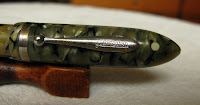Ges and Ter are the two rivers merging at the city of Torelló, the hometown of the pen company
Súper T. Putting both names together, the company founder Manuel Portus got the name for one of his creations: Gester. Four different Gester models were produced –20, 40, 60, 80— albeit with a number of variations along their thirty-something years of existence.
This is the review of a recently purchased Súper T Gester from around 1970—a model 20 with a steel nib.
 1. Appearance and design. (9.0/10)
1. Appearance and design. (9.0/10)This is a very appealing pen with an original design. Although originally inspired by the Parker 51, Manuel Portus managed to make a very distinctive tool. This Gester is made in navy blue plastic, with clip and cap ring in steel.

The clip deserves a close attention. It is made with a single piece of folded steel. This design was originally conceived for the model Olimpia (1960) and later adapted to the higher end Gester. This detail shows that this particular gester 20 was made around 1970.
2. Construction and quality. (8.5/10)This pen is solidly made with good quality plastic. All the elements fit well. The piston –yes, this is a piston filler— works flawlessly despite its 40 years of age.
Certainly, one could demand higher appealing materials, but the model 20 was the entry level to the Gester pen.
 Cap ring signed as "SUPER T GESTER".
Cap ring signed as "SUPER T GESTER".
This is a light pen with an excellent balance, especially if unposted. Average in size, its girth is comfortable on the hand.
Dimensions:
Length capped: 134 mm.
Length open: 122 mm.
Length posted: 149 mm.
Diameter: 11 mm
Weight: 18 g
 4. Nib and writing performance. (7.5/10)
4. Nib and writing performance. (7.5/10)This entry level pen has a very correct steel nib. It is smooth and has a very good and pleasant flow. Very rigid, no hint of giving under pressure.

The advertisements of the Gester pen in the 1950s spoke of up to 20 different nib points, but nowadays there are few chances to find them in the second hand market.
 October 1956 ad. The last paragraph speaks of 20 possible nibs. Advertisement collected by Grafopasión member Claudio.
October 1956 ad. The last paragraph speaks of 20 possible nibs. Advertisement collected by Grafopasión member Claudio. This is a piston filler. Unfortunately, there is no window to check the how much ink is left inside. On the positive side, section and barrel can easily be decoupled by unscrewing them. This eases the cleaning process and allows an easy access to the piston.
 The thin metallic ring separates the section from the barrel. The inscription reads "SUPER T 'GESTER' TORELLO ESPAÑA".
The thin metallic ring separates the section from the barrel. The inscription reads "SUPER T 'GESTER' TORELLO ESPAÑA".
Súper T pens were not cheap at their time. Some Gester models were more expensive than the luxury Parker 51. But Súper T pens were good quality tools.
 New Old Stock Gester 60 from mid 1960s with the price sticker on it. 750 pesetas was a small fortune. In comparison, a Parker 51 at that time cost about 500 pesetas.
New Old Stock Gester 60 from mid 1960s with the price sticker on it. 750 pesetas was a small fortune. In comparison, a Parker 51 at that time cost about 500 pesetas. After years of oblivion, Súper T pens are becoming popular among Spanish stylophiles and the demand is increasing. However, it is still possible to find them for less than €100 in excellent condition.
The conclusion is that I could buy a good quality writer for an acceptable price.
7. Conclusion. (49.5/60=82.5/100)Very well constructed pen with a reliable piston system. Smooth, but stiff nib with an excellent flow.
My thanks to fellow
Grafopasión forum members Alberto, Claudio and Olga.

(Súper T Gester 20 – Pilot Iroshizuku Kon-peki)
Bruno Taut
(Madrid, November 17-21th, 2010)
[labels: Súper T]
 The black stripped pens by the big three Japanese companies. From left to right, Pilot, Sailor and Platinum.
The black stripped pens by the big three Japanese companies. From left to right, Pilot, Sailor and Platinum. The three nibs. From left to right, the Sailor's in 18 K white gold, the Platinum's in golden 18 K gold, and the Pilot steel nib.
The three nibs. From left to right, the Sailor's in 18 K white gold, the Platinum's in golden 18 K gold, and the Pilot steel nib. 

















































